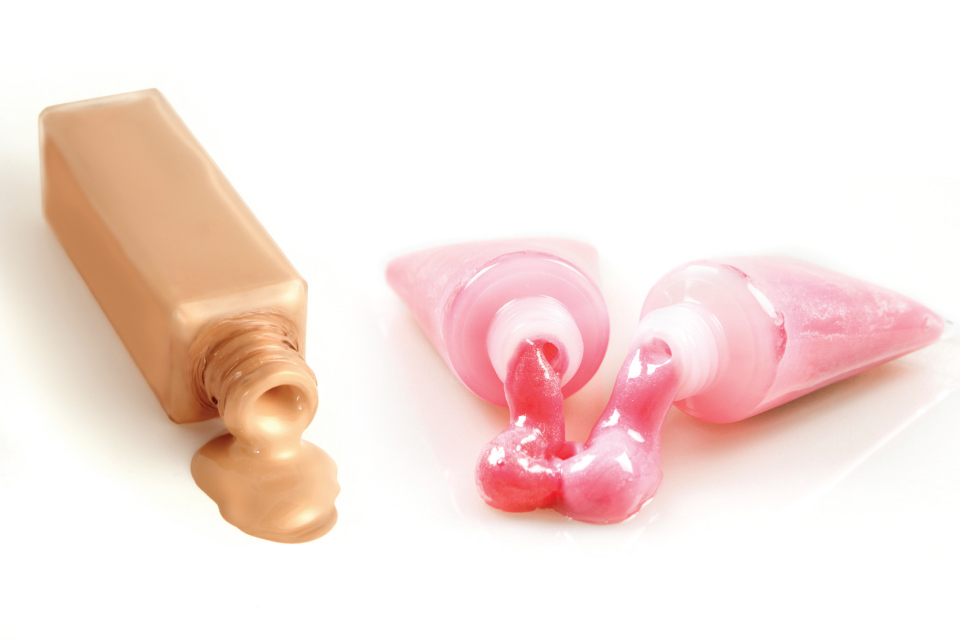Five Ingredients You Don’t Want in Your Makeup

With so many different brands of mineral makeup saturating the market and every line boasting that it is “natural” and beneficial to your skin, it is difficult to imagine how many toxic ingredients are used in some of our favorite cosmetic products. We absorb up to 60 percent of what we put on our skin, so consumers must be informed about the chemicals that are in their makeup and the effects that they have on their bodies.
Certainly, some people are more sensitive to various chemicals than others, but the effects of long-term exposure to many of these chemicals on humans is unknown. In Europe, the regulations are much more strict regarding which ingredients can go into makeup. The European Union (EU) doesn’t allow chemicals linked to cancer and birth defects into cosmetics, regardless of the percentage of the chemical being used. More than 1,000 ingredients banned in the EU are still being used in cosmetics in the United States. In fact, the Food and Drug Administration (FDA) has banned only 11 ingredients from makeup in the U.S. Additionally, several ingredients are restricted by regulation, meaning that they may be used in cosmetics, but only under the restrictions stated in the regulation. For many of the controversial ingredients, the FDA claims that the amount in products is not significant enough to cause harm to humans. Further, cosmetic ingredients are not subject to FDA premarket approval authority.
Petroleum products and petrochemicals
Petroleum distillates are banned in the EU but are still used in the U.S. in eye shadows, foundations, and mascaras. Petroleum distillates may cause contact dermatitis and have been linked to cancer. Petroleum products are often used in lip products because they are extremely inexpensive; however, they promote sun damage and cause dry skin and chapping. Some of these products can generate 1,4-dioxane, a substance that is known to cause cancer and is also a kidney and respiratory toxicant. The Environmental Working Group (EWG), an environmental health research and advocacy organization, has found that 22 percent of all products contain unsafe levels of 1,4-dioxane. When checking a cosmetic product for chemicals that can generate 1,4-dioxane, look for petroleum-based products such as sodium laureth sulfate, PEG, xynol, ceteareth, oleth, and ethoxylated. Cosmetic petrochemicals also include paraffin wax, mineral oil, toluene, benzene, phenoxyethanol, anything with DEA (diethanolamine) or MEA or ETA (ethanolamine), butanol, ethanol, methanol, isopropanol, BHA, and BHT.
BHA and BHT
BHA (butylated hydroxyanisole) and BHT (butylated hydroxytoluene) are synthetic antioxidants used as preservatives in cosmetics. They can induce allergic reactions in the skin, and BHA has been identified as a possible human carcinogen. BHA increases the skin’s sensitivity to damaging UVA and UVB rays and can be found in eyeliner, blush, mascara, eye shadow, lip gloss, and concealer. Long-term exposure to high doses of BHT is toxic in mice, causing liver, thyroid, and kidney problems, and affecting lung function and blood coagulation. BHT has been determined to cause tumors, and some evidence suggests that high doses of BHT may cause adverse reproductive affects.
Artificial fragrances
Artificial fragrances are used in cosmetics because they are much cheaper to produce than naturally occurring fragrances. They may contain hundreds of potentially harmful chemicals that won’t be listed in the ingredients, and will instead, simply be listed as “fragrance” or “parfum.” Fragrance recipes are considered to be trade secrets, so cosmetic companies are not obligated to disclose their ingredients to consumers. Many synthetic fragrances contain phthalates, which are toxic to the reproductive system. They also have been linked to health problems such as allergies, birth defects, breast cancer, and respiratory disorders. The chemicals in the artificial fragrances can cause headaches, dizziness, hyperpigmentation, coughing, vomiting, and skin irritation. Most lip glosses in the U.S. contain artificial fragrances.
PEG
Polyethylene glycol (PEG) is used as a moisturizing agent and is found in concealer, foundation and lip balms, even though it can be a skin irritant. PEG also enhances the penetration of other ingredients, allowing harmful ingredients access through the skin.
There are online databases available that consumers may consult, such as The Safe Cosmetics Program Product Database and the EWG’s Skin Deep Cosmetics Database, to determine if cosmetic brands contain any of these harmful chemicals. Also, if you are unable to view ingredient lists when making online cosmetics purchases, some companies will email you the information if you call to inquire.
Until ingredients used in cosmetics are more strictly regulated in the United States, consumers must be more aware of what exactly is in their makeup.






